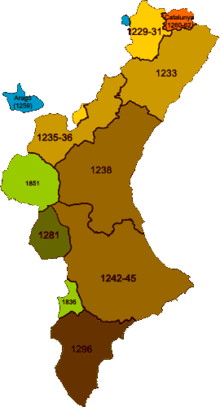This article has multiple issues. Please help improve it or discuss these issues on the talk page. (Learn how and when to remove these messages)
|
Kingdom of Valencia | |||||||||||
|---|---|---|---|---|---|---|---|---|---|---|---|
| 1238–1707 | |||||||||||
Associated emblem[1]
| |||||||||||
 Kingdom of Valencia and its administrative structure | |||||||||||
| Status | Realm of the Crown of Aragon | ||||||||||
| Capital | Valencia | ||||||||||
| Common languages | Valencian, Aragonese, Castilian, Andalusi Arabic[citation needed] and Latin | ||||||||||
| Religion |
| ||||||||||
| Government | Monarchy | ||||||||||
| King | |||||||||||
• First | James I of Aragon | ||||||||||
• Last | Philip V of Spain | ||||||||||
| Legislature | Valencian Courts | ||||||||||
| Historical era | Medieval / Early modern | ||||||||||
• Established | 1238 | ||||||||||
| 1707 | |||||||||||
| |||||||||||
| Today part of | Spain | ||||||||||

The Kingdom of Valencia (Valencian: Regne de València; Spanish: Reino de Valencia; Latin: Regnum Valentiae),[a] located in the eastern shore of the Iberian Peninsula, was one of the component realms of the Crown of Aragon.
The Kingdom of Valencia was formally created in 1238 when the Moorish taifa of Valencia was taken in the course of the Reconquista. It was dissolved, along the other components of the old crown of Aragon, by Philip V of Spain in 1707, by means of the Nueva Planta decrees, as a result of the Spanish War of Succession.
During its existence, the Kingdom of Valencia was ruled by the laws and institutions stated in the Furs (charters) of Valencia; these charters granted it wide self-government under the Crown of Aragon and, later on, under the Spanish Kingdom.
The boundaries and identity of the present Spanish autonomous community of the Valencian Community are essentially those of the former Kingdom of Valencia.
- ^ Presidència de la Generalitat Valenciana, La memoria del reino. 600 años de la Generalitat Valenciana, Presidència de la Generalitat
- ^ Hughes, Robert (2011). Barcelona. Knopf Doubleday Publishing Group. p. 3. ISBN 978-0307764614.
Cite error: There are <ref group=lower-alpha> tags or {{efn}} templates on this page, but the references will not show without a {{reflist|group=lower-alpha}} template or {{notelist}} template (see the help page).
![Associated emblem[1] of Valencia](http://upload.wikimedia.org/wikipedia/commons/thumb/1/1a/Aureum-Opus--portada.jpg/85px-Aureum-Opus--portada.jpg)